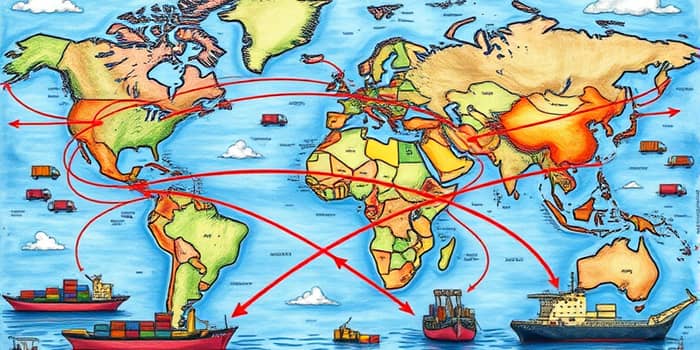
Global markets are navigating an era of unprecedented turbulence as supply chain shocks reverberate across industries and consumer behaviors evolve in response. In 2025, significant tariff hikes and policy shifts have injected a new level of complexity into how goods and services reach end users. From automotive parts to everyday groceries, disruptions in sourcing and logistics are reshaping price dynamics, availability, and long-term planning. This article delves deep into the forces driving these changes, offering insights and practical strategies to help both businesses and consumers adapt.
By examining the ripple effects of tariffs, inflationary pressures, and pandemic aftershocks, we will explore not only the challenges but also the emerging opportunities. You will discover key trends in consumer spending, learn how companies are reinforcing their networks, and gain actionable tips to navigate a shifting economic landscape. Whether you are a procurement manager, small business owner, or an informed shopper, understanding these trends can empower you to make smarter decisions and stay ahead in volatile times.
The past year has seen the U.S. implement aggressive tariff increases that target imports from major trading partners. Industries heavily reliant on cross-border inputs, such as automotive manufacturing and electronics assembly, have felt the strain most acutely. With import taxes escalating, tariff-induced inflation and policy uncertainty have become part of daily planning for procurement teams. As input costs rise, manufacturers are forced to pass on expenses to consumers or cut profit margins, triggering a domino effect on prices throughout the supply chain.
Regional economies that are deeply integrated into North American manufacturing hubs, particularly in states like Michigan and Ohio, face unique challenges. Loss of competitive advantage has fueled debates about reshoring versus diversification, and many firms are re-examining long-standing supplier relationships. The reality of navigating a policy environment in flux highlights the importance of agile planning and continuous supply chain visibility to anticipate and mitigate emerging disruptions.
On the demand side, U.S. consumer spending is projected to grow by 3.7% in 2025, down from 5.7% in 2024. This moderation reflects both strategic consumer spending and loyalty programs gaining traction and mounting concerns over rising living costs. Inflationary pressures driven by supply chain bottlenecks are forcing shoppers to become more intentional in their purchases, seeking value without sacrificing quality. The rise of digital coupons, cashback offers, and tiered loyalty rewards underscores a broader trend toward prudent financial management.
To illustrate these shifting behaviors, consider the following highlights:
Even as the acute phase of the global pandemic recedes, its lingering aftershocks continue to disrupt raw material flows and production schedules. Businesses are grappling with high raw material and component shortages, while regulatory compliance burdens have multiplied in response to evolving environmental and labor standards. Firms must now balance health protocols, shipping constraints, and fluctuating demand patterns, all underpinned by a new geopolitical landscape marked by uncertainty.
Geopolitical tensions, trade policy reversals, and regional conflicts have added further complexity. Supply chains that once relied on a few low-cost regions are diversifying to include alternative sourcing hubs. However, this diversification often comes with higher logistics costs, variable quality standards, and extended lead times. Developing a thorough risk assessment and contingency plan has become essential, especially for companies with perishable or time-sensitive goods.
In response to these pressures, businesses are deploying both short-term and long-term measures to safeguard operations. From emergency stockpiles to digital twin simulations, companies are strengthening their ability to respond rapidly to shocks. Embracing short-term emergency measures and long-term strategies allows organizations to maintain stability while they build future-ready systems. Consumers, for their part, can cultivate resilience by staying informed about market trends and adjusting purchasing habits proactively.
Looking ahead, global trade faces continued headwinds from regulatory shifts, logistical bottlenecks, and monetary policy responses to inflation. Central banks must weigh the impact of geopolitical instability and logistical challenges on core inflation, while policymakers consider how tariffs influence both domestic industries and consumer welfare. Regional disparities mean that some areas will rebound faster than others, depending on sectoral mix and exposure to international trade.
As a consumer, you can turn this information into a competitive advantage. Stay alert to price fluctuations, leverage loyalty programs, and explore alternative retail channels that offer cost savings. For businesses, continuous monitoring of geopolitical developments and supply chain metrics is crucial. Scenario planning and flexible contracts can help manage inventory and reduce exposure to sudden cost hikes.
In an era where change is the only constant, adaptability is the greatest asset. By understanding the forces reshaping supply chains, you can make informed choices—whether you are negotiating contracts, planning your household budget, or selecting your next purchase. Embrace data-driven insights, cultivate strategic partnerships, and remain agile in your decision-making process.
Supply chain shocks are not a temporary phenomenon but a structural reality of our interconnected world. Recognizing both the risks and opportunities they present will empower you to navigate uncertainty with confidence. As markets continue to evolve, your proactive approach to supply chain dynamics will be the key to thriving in an unpredictable future. Stay informed, stay flexible, and remember that every disruption carries the seed of innovation.
References













